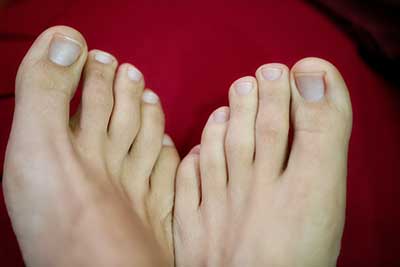What Causes Hammertoe?

Hammertoe is a deformity that occurs in the middle joint of one or more toes. The condition causes the toe to bend unnaturally due to an imbalance in the muscles or tendons that stabilize your foot.
Hammertoe can be caused by wearing ill-fitting shoes that crowd your toes or cause an unnatural bend, such high heels. The hereditary structure of your feet and legs can also cause the deformity. Even if you are not predisposed to developing the condition, certain medical conditions such as a stroke, spinal injury, or diabetes can cause nerve damage that lead to hammertoe.
What Does Hammertoe Look Like?
The bending caused by hammertoe is typically easy to spot. The unnatural stress on your muscles and tendons causes the middle joint of one or more toes to bend upward or sideways. It occurs most commonly in the three middle toes on each foot. You may also experience pain when bending or moving the impacted toes. You may also develop callouses on those toes after wearing tight or closed-toe shoes.
Are There Certain Risk Factors for Hammertoe?
Hammertoe can occur in men and women of virtually any age, but the following groups may have a higher risk of developing the condition:
- Women
- Older generations
- Those with a second toe longer than their big toe
- Those with nerve damage, possibly caused by diabetes, stroke, arthritis
- Those with hammertoe in their family
If left untreated, hammertoe will gradually get harder to fix with time. Identifying and treating it early will help you retain full range of motion and alleviate the unflattering look of the condition.
How Can I Prevent Hammertoe?
Preventive care can mitigate your risk for developing many foot or ankle problems, not just hammertoe. Proper shoes that fit correctly and adequately support your foot can lower your risk for many problems with posture, foot pain, back pain, and more. Look for shoes that have little to no heel, plenty of toe room, and adjustable laces or straps.
Certain exercises and stretches can help you control the symptoms of hammertoe or keep it from worsening. Dr. Dickerson will work with you directly to develop a plan that works best for your age, activity level, and the severity of your specific condition.
Hammertoe Surgery with Dr. Jason Dickerson
When non-surgical treatments or preventive care do not ease the symptoms of hammertoe, surgery can provide a longer-lasting solution. The delicate procedure is used to release a tendon that is causing the bend in your toe. By releasing it, your toe will be able to lie flat again. In some cases, small pieces of bone or other tissue may also be removed.
Your Reliable Resource for Hammertoe Treatment
Hammertoe can be an inconvenient and sometimes painful deformity. Dr. Jason Dickerson is Heiden Orthopedics’ highly-skilled, board certified food and ankle surgeon. Treatment for hammertoe requires precision and focus, and you won’t be disappointed with Dr. Dickerson’s attention to detail and informative patient care. He will bring you along every step of the way and help you avoid future instances of hammertoe.
2 Comments
Permalink
Wow, I didn’t know that having hammertoes would cause me to become imbalanced. I think I’ll undergo surgery from a good clinic so that the deformity would stop. This way, I’ll be able to retain full range of motion with my toes again.
Permalink
I just had the “k wire” surgery two weeks ago and for me I’m having hardly any pain and I’m not taking the regular pain medications that they gave me. I was stressed out going into the surgery but knew that it would relieve a lot of pain and I would be able to hike again, wear regular shoes again, and be able to stand at work with no problem. So🤞 for both of us and I wish you well.
P.S. The knee scooters are so much easier than crutches!